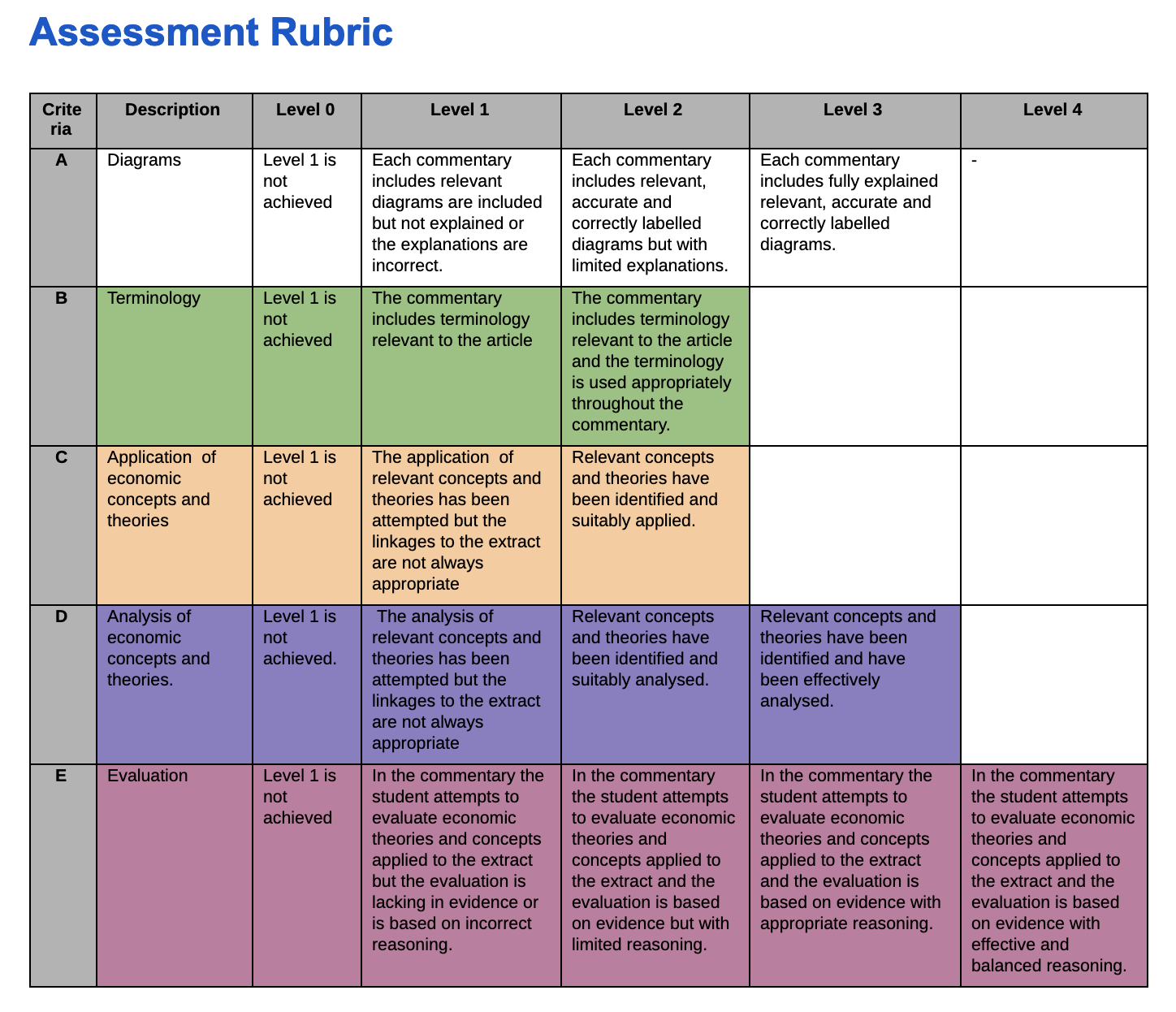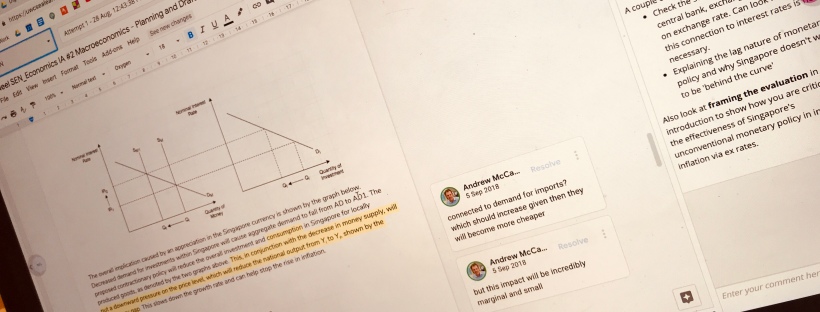Over the past few weeks I have been working with my Economics colleagues to moderate and mark our Internal Assessment for the IB Economics. We have over 100 students in each grade completing the course work so I am lucky (or maybe unlucky) to see lots of great examples. This blog post tries to highlight whats makes a great commentary stand out from the crowd.
Finding a great article
This is by far the most important ingredient. Get it right and you commentary and evaluation will write itself. If your article is too general, your analysis will end up vague and unimpressive.
The best articles explore an actual or proposed change in policy and describe some of the impacts on stakeholders and link this to data. A nice example is this article from the U.K on introducing a minimum price on alcohol – The Telegraph. A good article doesn’t give away the answers but helps you explain difference between an textbook, theoretical economic policy – in this case a minimum price on a good with negative consumption externalities and what happens in reality when this is introduced.
The quotes from the article below are a couple which can help you focus your evaluation.
- “However, more expensive drinks would be unaffected along with the vast majority of those sold in pubs” – does this therefore impact on equity. It is fair that low income households are impacted… if this effectively a regressive tax?
- “Ms Robison’s statement to MSPs came as new figures 36,235 hospital admissions were caused by alcohol in 2016/17, an increase of 2.4 per cent compared to the previous year.” Will introducing a minimum price reduce this? Will consumers act in rational ways or will they just switch to more expensive booze?
- “But she faced questions from opposition parties whether a minimum price of 50p per unit, the amount she intended to set when the legislation was passed in 2012, was still the correct level” – What is the correct level of pricing to fully internalise the external harms? Is it feasible to even guess what this might be?
The articles I always urge students to avoid come from publishers like Financial Times, The Economist, Bloomberg and especially any ‘blog post’ style opinion articles. Some of these articles discuss the economic impacts in too much depth leaving you as the student with little additional value to add.
One further thing to remember is your three commentaries need to come from three different sources… and be published within 12 months of your beginning your Internal Assessment, otherwise you will lose marks.
Clear and connected diagrams
A clear, precise diagram will support your analysis and must be included in your work. You are free to look at sample diagrams from textbooks, but you must draw these yourself; either electronically using something like Google Docs, or of course you can draw these by hand.
- Every diagram must relate to to the context of the article you have chosen. If data is exists in the article then it should be used to enhance axis labels (eg prices, currencies, or amount of change such as 20% are all great details to include)
- Labelling is crucially important … missing eg P, Q, AS, AD, rGDP, Average Price Level, or having these applied incorrectly to graphs etc will result in marks lost.
- Does the slope of your curves relate to the products explained in the article. If you article is about cigarettes then Demand Curve should be inelastic.
- Can you try highlight changes in community surplus? Can you illustrate changes in tax burdens? All of these details improve the rigour of your analysis…. just don’t get too carried away by labelling each box and use the entire alphabet A-Z.
- Be very careful about illustrating the difference between the introduction of a tariff/tax/subsidy versus the increase of the intervention. If it is an increase in a tariff from 5% to 15% you will need to show multiple tariff lines and also the original world price. This is a detail lots of students overlook.
Using appropriate terminology
Economists use specific technical terms to precisely describe a situation of policy and you should try use the most appropriate terms throughout your coursework.
- Prices change vs inflationary pressures increase, disinflation
- Tax vs specific tax, ad valorem tax, company tax, indirect tax
- Trade deal vs preferential trade agreement, bilateral agreement
- Small change vs less responsive to change in price or inelastic demand
A nice tip that I see some students use it to use bold format to highlight the 3 or 4 term concepts in the introduction. Overall this should be an easy criteria to attain the full 2/2 marks. You don’t need to formally define the key terms but your writing should clearly show you understand and can apply the correct concept.

Application – the right concepts for the article
Your analysis and evaluation should be as closely aligned to the context of the article as possible. For instance in the following article “UK Unemployment rises at fastest rate for over 5 years” you need to focus on explaining the concept of cyclical unemployment and monetary policy. You could go on tangents but if you overlook either of these you would struggle to attain 2/2. You can highlight the application by being super explicit with quotes
- make multiple, explicit, purposeful references to the article. Could be quotes, data, years etc
- Aim to use between 4-7 specific quotes which you integrate into your evaluation as evidence.
- If data is exists in the article then it should be included somewhere in the commentary and especially on the diagram.
- Highlight portions of your article which are relevant in yellow which you will use for evaluation. Especially for longer articles as this helps the examiner.
Analysis – how does this link to this?
Focused analysis unpacks and explains the economic theory in the article and explains how the concepts are connected. Using the example above you might explain the underlying causes of rising unemployment, explain what type of unemployment is occurring and using the diagram explain the mechanics of a disequilibrium where demand for labour falls relative to supply and impact that this has on wages which are typically downwards sticky. Exemplary commentaries take theoretical economics and identify how this works in the real world in the context of the article.
Good analysis will use economics tools to provide a depth of explanation that you might not see in a regular news paper article
- Consider using concepts of consumer, producer surplus to illustrate the impacts on different stakeholders
- Can an understanding of relative elasticities help develop the explanation. Will a change in price a more or less responsive change in quantity demand / supply overtime.
Evaluation – is this really going to work?
Economic policies are often changed or arise because of political motivations; for instance advocating for minimum wage changes or trade protectionist policies to appeal to voters or campaign promises.
An exemplary commentary will critically evaluate how theoretical economic policies will work in the real world where the behaviours of consumers and producers are often far from rationale
Take the example of trade protectionist policies implemented by Donald Trump and the US Republicans. The premise of the policy is to protect jobs in USA and to improve the trade deficit. Therefore there are a couple of essential points you can evaluate, and connect to the assumptions outlined in the article.
- How many jobs are really being protected?
- How does higher price of steel imports impact producers of related goods such as windows or cars?
- But consumers will have the pay higher prices for imported products and those including steel components?
- Does the number of jobs being protected outweigh and the number of consumers paying higher prices for related goods?
- Are we protecting a dying sunset industry or a new infant industry?
- Is the global allocation of resources getting better or worse? Why are we ignore the laws of comparative advantage?
- Is there a more efficient / equitable solution?
There are other important points to be careful about. Any judgements and evaluations should make sense given the country and current context. e.g. “Japan should drop interest rates… when interest rates are already at 0.25%” would show a lack of context and understanding. Similarly students would be wrong to advocate for pursing monetary policy in EU countries such as Spain which are constrained by a common Central Bank interest rate.
Finally try wrap up your essay with a final judgement or synthesis, bringing significant aspects of the article together in context of the country and suggesting a way forward. Below are a couple of nice examples of analysis and evaluation.
And don’t forget…
It is pretty tricky to squeeze all of this into 750 words, and hence the top grades are really hard to attain. Your overall portfolio of 3 commentaries has to also meet the critiria
- Maximum 750 words – Word count includes quotes, but not references. Can include some annotations on diagram but beyond 10 words will count to overall word count of 750.
- Sources – each commentary is based on source which comes from a different publication. Don’t use the New York Times for all three ! It is not a requirement but a good portfolio has a geographic spread, perhaps focusing on different countries or nations with differing levels of development.
- Cover three sections of the syllabus – you must write one commentary focused on a topic from microeconomics, one on macroeconomics and the final one on international trade.
A small caveat is to be particularly careful about using minimum wage as commentary for microeconomics as most of the evaluation sits within a different topic macroeconomics. Overall we encourage our students to use minimum wage as part of macroeconomics. There are a couple other examples of this where you need to ensure you focus the majority of the evaluation on the relevant section of the syllabus (e.g. monetary policy and discussing the implications on exchange rates and trade would tricky for examiner to give full marks)

Extra resources
Wow this post has become longer than I envisaged !
The following Google Doc has two example commentaries which I use with my students to begin the process. If gives you an idea of what you are writing. A nice activity is to highlight the different application / analysis . evaluation aspects of the commentary, and to refer to the rubric to assess the student work.
The other good resource is a couple of YouTube tutorials by a colleague Jason Welker. Very comprehensive as usual and a nice insight to how he supports his students.






